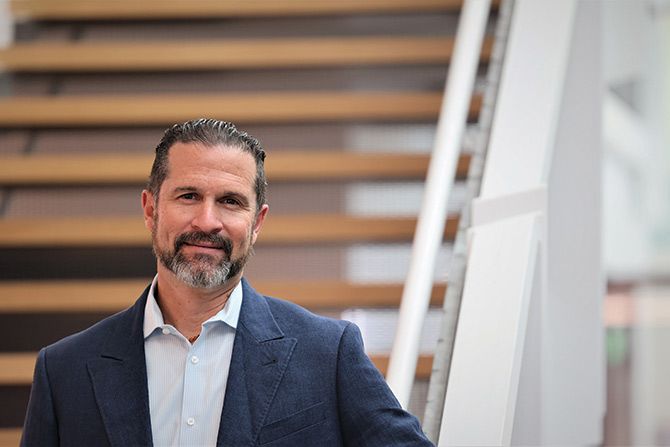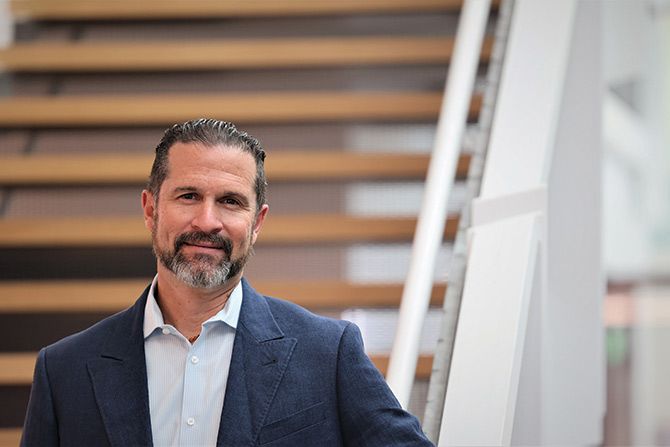Robert Piñon, AIA, LEED AP and MHTN Architects’ Vice President over Commercial and Municipal Sectors, is the current AIA Utah president. MHTN was founded in 1923 by Ray Ashton and Ray Evans. The company has been involved in many important Utah projects, such as the University of Utah School of Business (2012), Utah Valley Convention Center (2012), and Salt Lake County District Attorney Office (2020). The firm is nationally recognized and currently employs 36 licensed architects.
Robert is a longtime member of AIA hired in 1996 at MHTN as a drafter. He graduated from the University of Utah in 2001, with a master’s degree in architecture and has worked in every area of the company since he was hired.
Robert’s father was a Texas-born embassy employee who married a Spanish woman he met while serving in the U.S. Air Force. As a result, the family moved from capital to capital in countries such as Chile, Honduras, Ireland and Portugal, and Robert attended international schools.
During Robert’s childhood and youth, he never lived anywhere for more than two to four years. He played varsity basketball and graduated from high school in Chile 30 years ago. His Eagle Scout project involved updating a children’s playground at a local Chilean kindergarten. Robert also spent two years in Japan on a church mission. He is multilingual and speaks English, Spanish, Portuguese and Japanese.
He and his wife have two sons and enjoy traveling. Robert is preparing for Lotoja, a 206-mile bike ride from Logan to Jackson. He also coaches his sons’ soccer team. He enjoys skiing at Alta and exploring southern Utah’s deserts.
AIA Utah recently spoke with Robert about his life, work and AIA.

Why did you become an architect?
I love airplanes and originally wanted to be a pilot, but I also loved Legos. When I was 14, I realized how perfect vision is temporary and crucial for pilots. I worried that I wouldn’t always have perfect vision. So I switched career paths.
There is magic in creating space and changing environments. The profession of architecture combines design and art, and it is tactile. I enjoy all of that.
Please tell us about your studies at the University of Utah. What was the most important lesson you learned during your time there?
My professors helped me think and explore. I gained the ability to critically think through problems, be confident in my thought process and find my ground. There were challenges and opportunities to test things I wouldn’t have considered otherwise. I learned about important practical skills such as communication with teams and colleagues. While there, I took two business classes because I was looking for additional skill sets, and I worked within the Kajima Lab, a 3D software lab hosted by a Japanese construction company. The professors taught us mechanical concepts, building science, structure and design. I learned how to communicate with clients and set priorities and needs.
Who have your most important mentors been?
I worked under Pat McLaughlin for six years, starting on day one. He taught me to always seek out options and to be open-minded. He encouraged me to get involved with AIA early in my career. He moved to Portland before COVID to be closer to his daughter, but he continues to be a good influence. He also taught me how important it is to start saving for retirement early, time being your greatest asset.
Dennis Cecchini, our former CEO and AIA past president, also mentored me. He instilled confidence in making necessary decisions quickly so projects could move forward. His passion for architecture and securing a client’s satisfaction has remained with me. And then there is golf – the etiquette and value of spending time with others; we’ve enjoyed many rounds on the greens!
It’s rare to talk with someone who has focused on one company. Please tell us about how you arrived there and why you stayed.
Until I came to Utah, I typically moved every two years; the longest I stayed anywhere was four years. Salt Lake City is welcoming, and we are very comfortable with Utah’s outdoors and the culture. My wife and I have had amazing careers here. I connect with the firm’s mission to create extraordinary environments, and there’s never been a lack of work or challenge. We fit here.
I have also had the great fortune of working on projects that have captured my imagination. I have even gotten to design airports and revisit my love of that building type.
When I was working on my master’s project at the University of Utah, my project was the Provo City Airport, and twenty years later, we were able to design and stamp an airport for Provo. That was one of my favorite projects. It’s been updated to be suitable for Provo’s current need; it’s now a four-gate terminal that opened in May this year. I’ve also been involved for 20 years with the work being done at the Salt Lake City International Airport, old and new.
How has AIA been helpful to you as an architect? Why is membership important?
AIA Utah puts architects first. The association allows architects to continue their education, share and network. Also, the advocacy part of any association is huge. Our voices are stronger when we are united.
The pandemic has been challenging for everyone. The last two years were very isolating, but now is the time for AIA Utah to support and enable architects and be a resource for them. We have completed some of our past promises, like adding signage to our AIA Utah office. Utah members want more emphasis and focus on good architecture; we hear that and are working on it with tours, awards, and celebrating the 100 Best Buildings in Utah. We also want to get people out of the office and into the same room more often now that it is safer. For instance, conferences can revitalize and reinvigorate our creativity – they can suggest methods and insulate ideas that find our way into our projects.
The National AIA Conference in Chicago was inspiring. President Obama gave the keynote and spoke to 10,000 architects on the value of good design, referencing the amazing built environment of his hometown (Chicago). At the same conference, Studio Gang’s Jeanne Gang talked about how buildings can create community, and she gave an example by talking about a police station’s design. Police stations are traditionally isolated. You can feel the power and that can be off-putting. To change public perceptions about police work, Studio Gang designed the building differently, proposing that police stations become community centers and provide a safe place where people are welcome. Architects are putting their ideas into action in Chicago’s North Lawndale neighborhood.
How and why did you get involved in a leadership role
at AIA?
In the past, I’ve served as the treasurer and a board member. I’ve also been treasurer for the Utah Center for Architecture (UCFA). Now, it is my turn to step up and guide the association. Last year, as president-elect, I was in charge of the fall conference. Next year I will plan the golf tournament. I really enjoy working with my peers from other architectural firms on joint projects. Our design community has so much intelligence and talent, and we don’t often get to collaborate. Involvement in AIA Utah can be stimulating.
What do you plan to accomplish during the remainder of your term? What are the biggest problems currently facing AIA?
Now that we have moved into an endemic mode, we want to serve members by providing them with a voice, education and advocacy. People are still struggling from the isolation the pandemic caused, but committees can provide purpose by promoting renewal. We held a strategic planning session in March and developed goals centered around “helping architects be better architects.”
We are working with our members’ firms and with allied professions in the A/E/C industry to encourage stronger involvement and participation in activities. Additionally, we are strengthening our ties with the University and revitalizing the Young Architects Forum. We want the younger generation to connect, and we want to help talent stay local.
For instance, in the fall, I will teach a graduate-level studio class at the AIA office. Its purpose is to connect students to the profession with a real project. The class will begin in mid-August when the semester starts. The class will give students a true experience of what it’s like to be an architect. I will be bringing in guest speakers from the industry, including structural, civil, and MEP Engineers.
What would you like to say in summary to the AIA members who will be reading your article?
We decided that right now, it’s all about connecting and reconnecting people. We also want to connect with students and help architects adjust to being back in the office. We want to provide networking opportunities. We want to help architects enjoy their jobs, be successful, and create community again.






